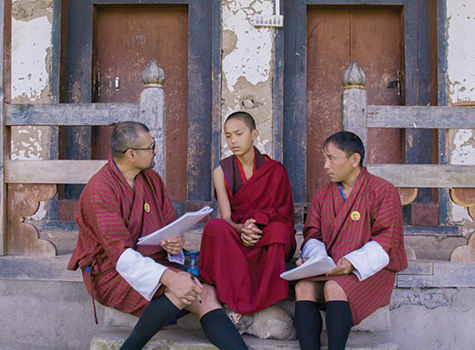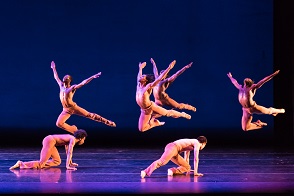
At the time of this writing, the 85rh annual American Dance Festival (ADF) is in its final week. For many, the passage of the ADF season is a reminder of the fleeting of summer. For me, it’s been particularly fast – memorable with a nice diversity of programs but even shorter than usual with about a week’s less programming. Still, all told, there will be 53 performances by 26 companies, down a bit from last year’s 71 shows by 30 groups.
I loved seeing Dayton Contemporary Dance Company (DCDC) on the second night of ADF in a full-length evening performance, and then again at their Saturday matinee, a 1-hour show focused on children. DCDC was formed in 1968 rooted in developing themes of and for dancers of color. Their 1959 dance Rainbow ‘Round My Shoulder was their most concrete and powerful one, reenacting the prison chain gang with a grim rhythm; inevitably the dreams about a loved woman results in escape but the unmistakable explosion of a sudden gunshot ends the performance. They also had a very short few-minute-long 1932 dance Awassa Astrige/Ostrich solo emulating a proud ostrich, a perfect antidote to the disturbing ending of Rainbow.
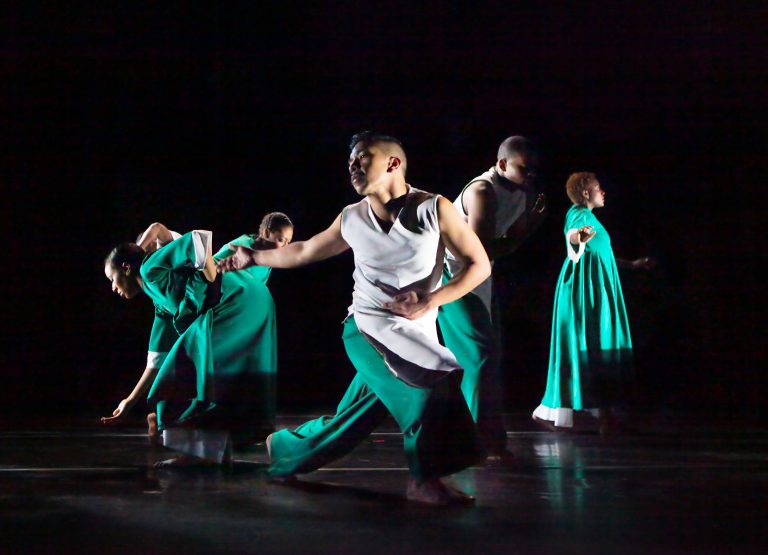
Ronald K. Brown/Evidence was another favorite for me. I haven’t met Ronald K. Brown but from what I gather from seeing him on stage and stories about his demeanor, he seems to be gentle and kind, while focused on pushing his dancers for excellence. I attended the show on the night that he was presented with the prestigious annual Scripps/ADF Award for Lifetime Achievement, rather remarkable for somebody in mid-age.
The company performed Torch, an excerpt from Lessons: March, Walking Out the Dark, and a final dance to the music of Stevie Wonder, excerpts from On Earth Together. Lessons: March is a duet set mostly to a lesser known speech of Martin Luther King, Jr’s. The thing that impressed me most about this was the fact that he had the confidence and ability to choreograph to the incomparable oratory of MLK, Jr. I even asked him in the post-performance discussion if it was a bit unfair to his dancers; I had trouble focusing on them until the speech faded away to music. That piece went very well with On Earth Together in which we are politely but firmly reminded that people of color still face discrimination. That ended with a joyous celebration; he had worked with folks from the local community ranging in age from 8 to over 70, and they came out, as did he, to dance, quite well considering their short rehearsal time, with a big, smiling dollop of hope and optimism.
Pilobolus and Paul Taylor Dance Company gave, as always, very satisfying and interesting performances. I always find many things to marvel about in Pilobolus’ shows, and this year was particularly excited by their world premiere starting piece, Eye Opening. The show “soft opened” with an audience member on stage helping with a zany skit about eyes. Their program included five dances, including last year’s clever Branches with a soundtrack including actual bird calls. That was the single dance that they performed at the children’s matinee; I wish that they could have included Eye Opening.
Surprisingly, and no doubt due to scheduling, Paul Taylor Dance Company (PTDC) only performed two nights, and mid-week at that. The show was about 95 minutes long including two intermissions, one in between each of their three dances, Roses, Half Life, and Mercuric Tidings. This season I often pined for other companies to separate their dances with intermissions to allow each piece its digestion time and have the evening unwind unhurriedly. I particularly enjoyed the darkly powerful Half Life, with dancers scurrying around in low-hanging lights in what looked like a bunker or bomb shelter. Roses was a quiet piece with five pairs of dancers in grey and brown and one pair in off-white, dancing to music by Richard Wagner and Heinrich Baermann. It was good to see Mercuric Tidings again; the pink costumes on pink background to Franz Schubert’s music most appealed to me as a photographer with its dynamic asymmetric balance.
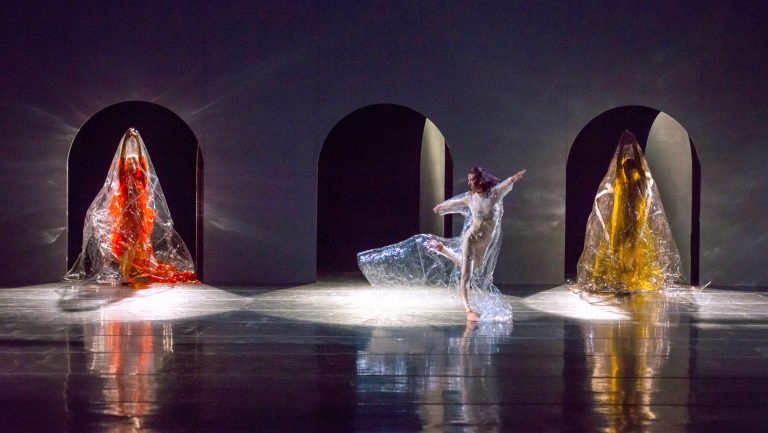
I often am drawn to the abstract dances of Shen Wei Dance Arts. This year, they had a rather short single-dance evening, performing their 2016 Neither. The idea of using the 1977 opera by the same name by Morton Feldman and Samuel Beckett as the inspiration was intellectually appealing, and I enjoyed their surreal plastic-like encasing costumes, but I found the dance, to me, rather inexplicable and distant. Nevertheless, I was glad to have seen Shen Wei and would have been quite happy to have had an intermission and second piece that perhaps I could better relate to.
Places Please! with veteran choreographers and dancers Nicolle Wolcott and Larry Keigwin was, I believe, the first live performance to be given in Duke University’s striking new Rubenstein Arts Center and its intimate von der Heyden Studio Theater (you may have to step on the stage to get to your seat!). Before showtime, the two dancers were already on stage, fussing with the set and their wardrobes. They slowly began the show, a tongue-in-cheek behind-the-scenes peek into what goes on in putting together a performance, as well as serious asides into aging and the concept of when a dancer is perhaps “too old” (we are reassured that the answer can be “never”).
Anne Plamondon offered a stark, soul-bearing autobiographical peek into her life with her declining father. Her solo dance The Same Eyes as Yours was appropriately performed as well in the von der Heyden Studio Theater. The insightful discussion with Ms. Plamondon immediately after the dance revealed her struggle with winning her confidence in taking the stage and overcoming feelings of ego to portray her deeply personal story.
Coming Home: ADF Alumni Return was a collection of five dances from past ADF students. I enjoyed the artful falling in a stark black and white set and costume of soloist Burr Johnson’s Untitled set to a pop-techno song by a group called Girls’ Generation. Raja Feather Kelly choreographed six dancers in TedX on Love, a humorous critique. I felt that this piece could have been much shorter as it overplayed its theme, but I was impressed with the costumes which covered the faces of each dancer in bright fabric – how could they breathe effectively?!
The most recent performance that I attended was Wondrous Women: Solos Created by the Artists for Themselves. It was a remarkable but too-short night of solos. What was remarkable was how each piece was strongly introspective, portraying each woman as a mighty victor of her circumstances, yet each quite unique and different from the others. Camille A. Brown opened the night with two musicians of African percussion on stage for her solo dance excerpt from ink in which we palpably experience her search for identity and rising above of inequity.
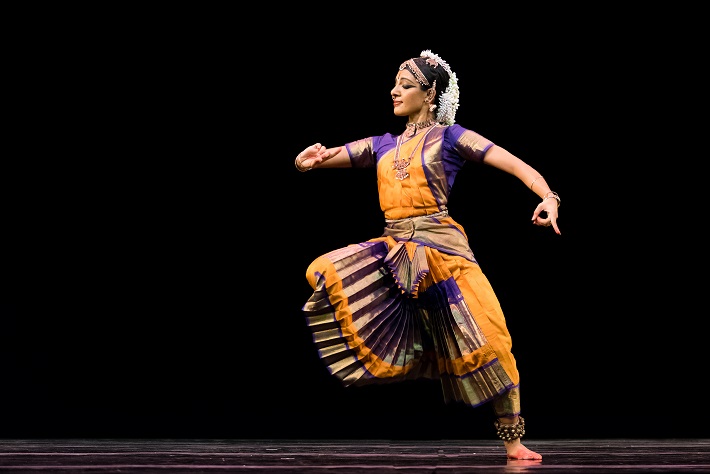
As I had written in last month’s column, Aparna Ramaswamy returned from Minneapolis and gave a stirring world premiere of an ADF-commissioned dance, Ishvara. Nature is called to satisfy the longing for Vishnu. I was fortunate to be in the second row so I could admire details of Ms. Ramaswamy’s expressiveness and smiles of enchantment. I strongly recommend that Saathee readers jump on any future opportunities to enjoy the entire Ragamala Dance Company or Aparna Ramaswamy’s solo work.
Perhaps my favorite piece of the night was Chinese choreographer Yabin Wang’s The Invisible Entanglement. Often shrouded in her black dress and her own long hair, Ms. Wang assumed meditative stances in her nuanced dance that reminded me of Japanese dance couple Eiko & Koma.
Rhapsody James performed Phase 4: In God’s Design We Trust. She danced in front of projected images reflecting stages in her creative life. I appreciated her unapologetic portrayal of honest struggle and complex dissection of issues such as living on the east vs. west coast, all couched with positive body image.
North Carolina native tap dancer Michelle Dorrance concluded the evening with a stirring piece thenow with syncopated tap beats and circular movement. There was no intermission and the vibe it left behind was an audience wanting more – perhaps one or two more soloists would have nicely rounded out the evening.
I’m looking forward in ADF’s last week of July 16th to seeing Dana Ruttenberg Dance Group lead small audiences of about 30 to interact with art at the North Carolina Museum of Art. Kyle Abraham’s “A.I.M.” later in the week at the von der Heyden Studio Theater uses solos and duets to explore identity, and is said to also include some audience participation. ADF ends with Footprints, a night of three commissioned works by Dafi Altabeb, Abby Zbikowski, and Jillian Peña.
Full details about ADF are available at www.americandancefestival.org. I tweet as @dbarman from the performances.
Note: Photographs and American Dance Festival logo courtesy of American Dance Festival. All pictures are used with permission.

